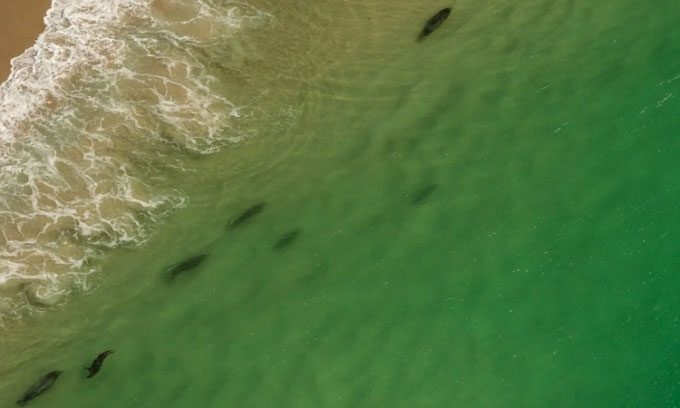The Cape Cod region in Massachusetts has approximately 800 to 900 sharks swimming through its waters from 2015 to 2018, potentially making it the highest shark density in the world.
The exact number of sharks lurking in the Cape Cod waters is challenging to determine due to the complexity of counting these elusive creatures over such a vast area. However, researchers from the Atlantic White Shark Conservancy have found answers by combining acoustic tracking, photo identification, and statistical modeling.
According to the research results, there are about 800 to 900 sharks swimming in Cape Cod waters between 2015 and 2018, as reported by National Geographic. For comparison, the estimated number of white sharks off the coast of California is about 300. “The shark density in Cape Cod is likely the highest in the world,” stated Megan Winton, a fisheries scientist who collected the data.

White sharks swimming near the shore at Cape Cod. (Photo: National Geographic).
This remarkable discovery is significant not only because of the number of sharks but also due to the fact that they are concentrated along more than 900 kilometers of coastline. Four years of monitoring revealed that the sharks, primarily adults measuring between 2.4 to 3.7 meters long, spend about half of their time in waters deeper than 4.6 meters.
“People may know that white sharks come here, but they think they are far offshore,” Winton said. “We have seen sharks as long as 4.6 meters in waters only 1.2 to 1.5 meters deep. Their camouflage ability is incredible. People can be right next to them without even seeing them.”
White sharks are thriving in Cape Cod for a simple reason: their preferred prey, the gray seal, is recovering. Once hunted to near extinction, the gray seal population has begun to rebound since the Marine Mammal Protection Act was enacted in the U.S. in 1972. Today, their numbers have reached up to 50,000. White sharks, a species that was once listed as vulnerable by the International Union for Conservation of Nature, take longer to recover. However, thanks to nationwide protection in 1997 and state-level protection in Massachusetts in 2005, the shark population is steadily growing in the eastern U.S.
According to Greg Skomal, a fisheries scientist at the Massachusetts Division of Marine Fisheries, the risk of shark bites is very low, and swimmers are more likely to drown. There have only been 5 shark bite incidents in Cape Cod since 2012, including one fatality in 2018. To reduce the risk of encounters between sharks and humans, scientists need to know where and when the sharks are swimming.
To investigate, the research team in Cape Cod created a shark identification catalog by tagging or taking pictures of their dorsal fins from 2015 to 2018. They then conducted surveys over 3 years, comparing newly photographed sharks with previously recorded ones, and recreating encounters through statistical modeling to estimate the population. Unlike previous surveys in South Africa, California, and elsewhere, Winton’s model considers shark movement. This new model allows for an understanding of where sharks prefer to congregate along the coast.
The use of high-quality mobile underwater cameras has made shark identification easier and more accurate. Additionally, the team of experts at the Cape Cod Coastal Research Center also utilized sonar surveys to map the movements of the sharks.
White sharks are ambush predators, often lurking in deep waters and leaping high to surprise their targets. However, along the Cape Cod coastline, sharks are forced to hunt in shallow waters. They do this by loitering in the troughs between sandbars, waiting for hungry seals to come down to the water to feed. Understanding this unusual behavior will help experts predict shark movements and identify particularly hazardous areas for swimmers.
Since 2009, the Cape Cod research team has tagged a total of 303 sharks with acoustic transmitters. Five tracking devices can detect acoustic signals when tagged sharks swim by, transmitting real-time information to lifeguards, beach managers, scientists, and the community through an app.


















































